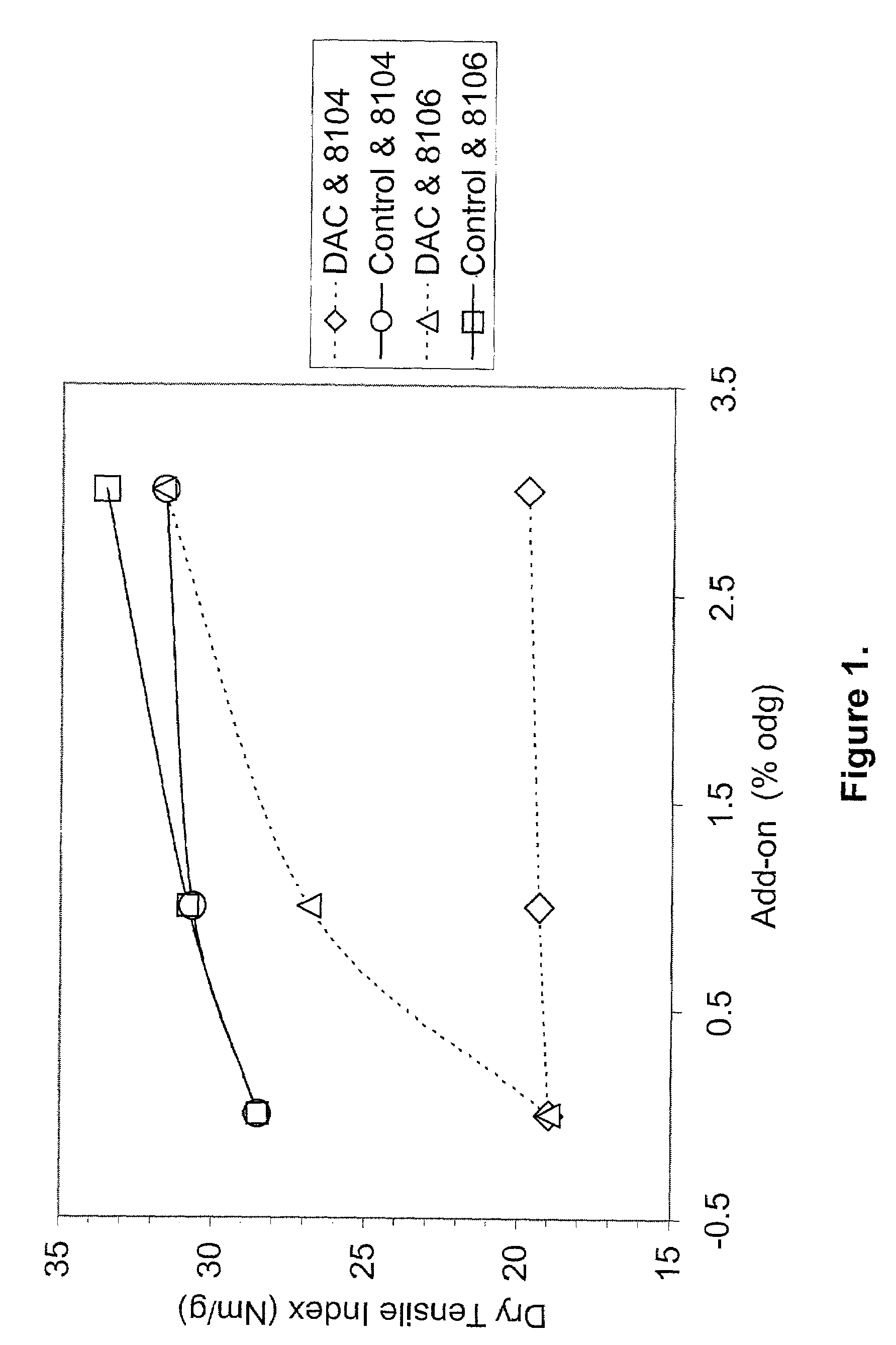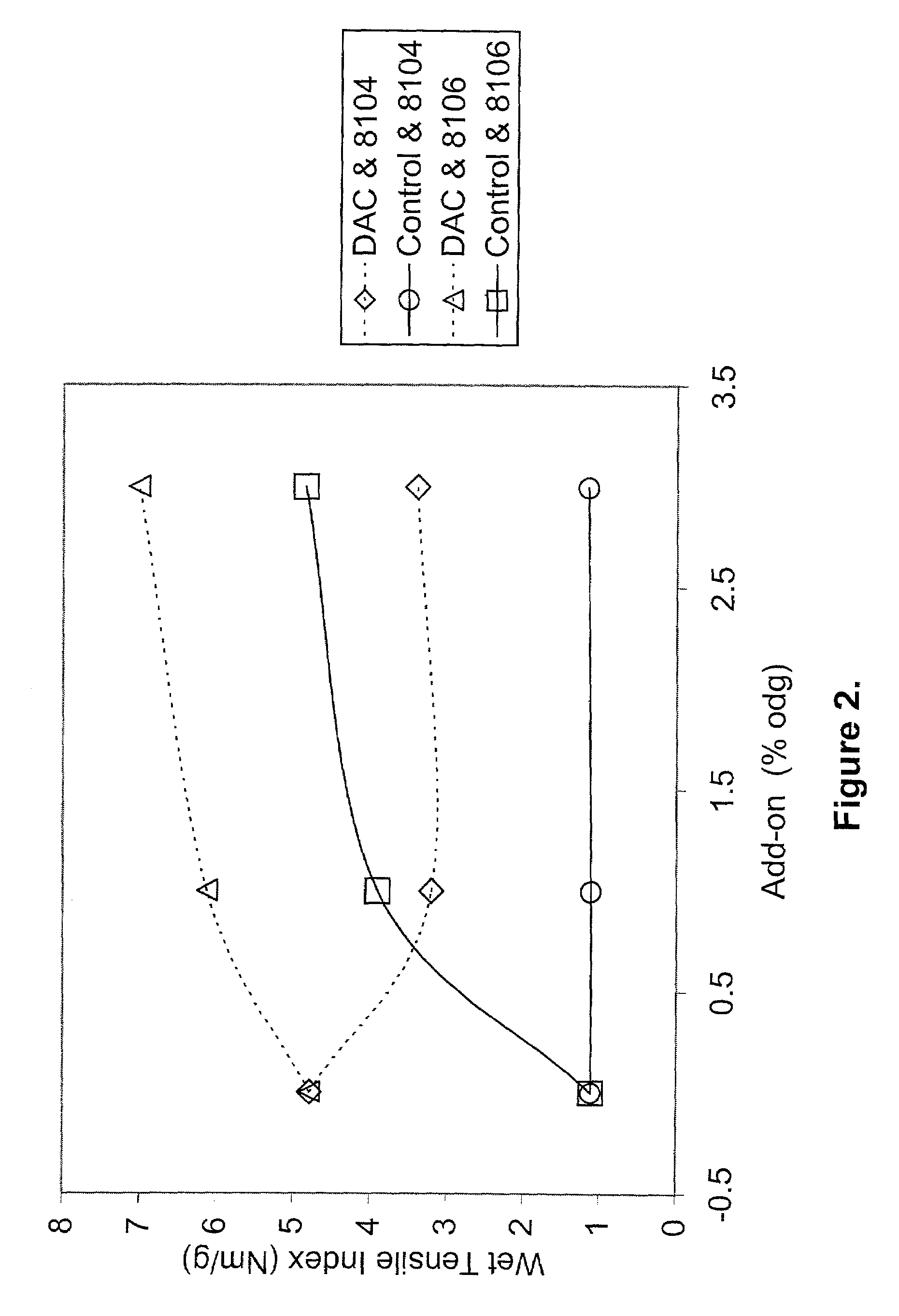Polyvinylamine treatments to improve dyeing of cellulosic materials
a cellulosic material and polyvinylamine technology, applied in the direction of colorants/pigments addition, synthetic resin layered products, printing, etc., can solve the problem that wet strength agents should not prevent the disintegration of bath tissue, and achieve the effect of increasing the wet strength of paper products and facilitating the dyeing of fibrous materials
- Summary
- Abstract
- Description
- Claims
- Application Information
AI Technical Summary
Benefits of technology
Problems solved by technology
Method used
Image
Examples
example 1
[0144]The strength benefits of polyvinylamine were explored with application to an uncreped through-dried tissue having a basis weight of 43 gsm, generally made according to the uncreped through-air dried method as disclosed in U.S. Pat. No. 5,048,589 to Cook et al. The tissue was made from a 50 / 50 blend of Fox River RF recycled fibers and Kimberly-Clark Mobile wet lap bleached kraft softwood fibers (Mobile, Ala.). The fibers were converted to a dilute slurry of about 0.5% consistency and formed into a web onto a pilot paper machine operating at 40 feet per minute. The embryonic web was dewatered by foils and vacuum boxes to about 18% consistency, whereupon the web was transferred to a through drying fabric with 15% rush transfer, meaning that the through drying fabric traveled at a velocity 15% less than the forming wire and that the differential velocity transfer occurred over a vacuum pickup shoe, as described in U.S. Pat. No. 5,667,636 to Engel et al. Through drying was done on ...
example 2
[0157]The untreated tissue and the solutions of Example 1 were employed again to explore the generation of hydrophobic properties associated with Trial C. In this example, however, the tissue was treated with a uniform application of both compounds simultaneously. The polyvinylamine solution was directly mixed with the PARC solution prior to application to the tissue. Thus, 5 ml of 0.5% Catiofast® PR 8106 were mixed at 73° F. with 5 ml of the PARC solution. The solution rapidly became cloudy, as if a colloidal suspension had formed. A similar mixture was also prepared using 5 ml of 0.5% Catiofast® PR 8104 which were mixed with 5 ml of the PARC solution. This second mixture remained clear. It is believed that the more highly hydrolyzed Catiofast® PR 8106 solution formed polyelectrolyte complexes with the anionic polymer that created a colloidal suspension.
[0158]The two mixtures were then applied to separate regions of another 8-inch by 8-inch tissue sample. The cloudy mixture of Cati...
example 3
[0159]Sections of the tissue used in Example 1 were treated with aqueous solutions of 0.5% Catiofast® PR 8106 (a polyvinylamine) and / or PARC (0.5% of DP80 with 0.25% of sodium hypophosphite) or mixtures thereof. Three mixtures of the polyvinylamine and PARC were prepared with ratios of 30:70, 50:50, and 70:30. For each trial, 5 tissue samples were cut into 5-inch by 8-inch rectangles, with the 8-inch dimension being in the cross direction of the web. Most of the trials comprised spraying a total mass of treatment solution(s) having 350% of the dry mass of the web (relative to the web at room conditions, with about 5% moisture already in the “dry” web in a room with a relative humidity of about 30% and a temperature of about 72° F.). In some trials, a mixture of the PARC and polyvinylamine was applied to the web. In other trials, both compounds were applied separately. In the latter case, trials were conducted in which either the PARC or the polyvinylamine were applied first. At that...
PUM
| Property | Measurement | Unit |
|---|---|---|
| Time | aaaaa | aaaaa |
| Time | aaaaa | aaaaa |
| Water Drop Intake Time | aaaaa | aaaaa |
Abstract
Description
Claims
Application Information
 Login to View More
Login to View More - R&D
- Intellectual Property
- Life Sciences
- Materials
- Tech Scout
- Unparalleled Data Quality
- Higher Quality Content
- 60% Fewer Hallucinations
Browse by: Latest US Patents, China's latest patents, Technical Efficacy Thesaurus, Application Domain, Technology Topic, Popular Technical Reports.
© 2025 PatSnap. All rights reserved.Legal|Privacy policy|Modern Slavery Act Transparency Statement|Sitemap|About US| Contact US: help@patsnap.com



